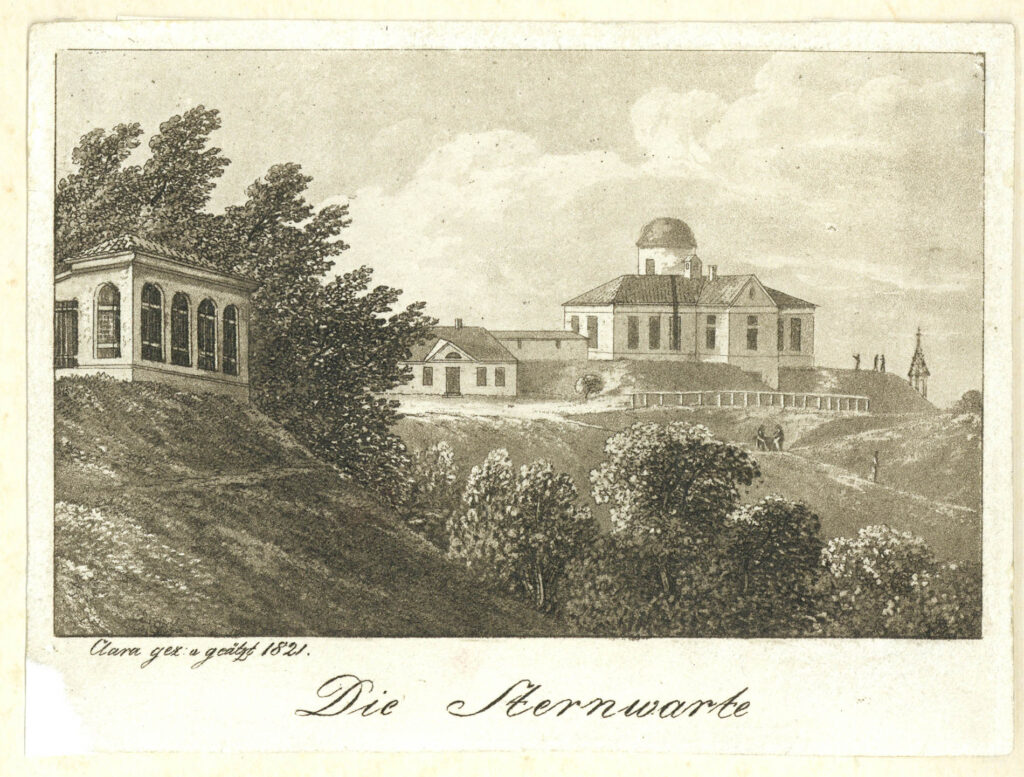KP4
EST:
Tähetorn
Illustratsioon: Tartu tähetorni esialgne kuppel
Autor: August Philipp Clara, 1821 (Tartu Ülikooli raamatukogu).
Toomemäe kõrgeimasse paika, endise piiskopilinnuse asukohta ehitatud tähetorn valmis Johann Wilhelm Krause kavandi järgi 1810. aastal. Hoone projekteerimisel võeti eeskuju Gotha, Göttingeni ja Uppsala ülikooli observatooriumidest.
Tartu tähetorn oli esimene moodsa lahendusega observatoorium Vene impeeriumis. Hoone ida- ja läänesaali rajati vaatlusteks seina- ja katuseluugid, torni kattis algul kuppel. Kui 1824. aastal toodi tähetorni toona suurim teleskoop maailmas – Fraunhoferi refraktor –, asendati kuppel torniga, mille ülaosa on võimalik käsitsi pöörata. Torni kavandid said seejärel eeskujuks mitmele observatooriumile üle Euroopa.
Hoonest paremale poole jääb kunagine astronoomi elamu, mida parasjagu renoveeritakse, vasakule poole aga kaks paviljoni. Toomemäe nõlval paikneb väike teleskoobitorn, mis on kaetud tänavakunstiga.
Aastatel 1818–1839 oli Tartu tähetorni direktor maailmakuulus astronoom ja geodeet Friedrich Georg Wilhelm Struve. Osana Struve geodeetilisest kaarest kuulub Tartu tähetorn UNESCO maailmapärandisse.
ENG:
Old Observatory
Original dome of the Old Observatory
Author: August Philipp Clara, 1821 (University of Tartu Library)
The observatory was built at the highest point of Toome Hill, the site of the former bishop’s castle,
based on the designs by Johann Wilhelm Krause. The building was completed in 1810. Its design was
inspired by the observatories of the universities of Gotha, Göttingen and Uppsala.
Tartu Old Observatory was the first modern observatory in the Russian Empire. Its east and west
halls were equipped with wall and roof apertures for observations, and the tower was initially
covered by a dome. When the world’s largest telescope at the time, the Fraunhofer refractor, was
brought to the observatory in 1824, the dome was replaced with a tower that had a manually
rotatable top. The design of the tower then became a model for many observatories across Europe.
To the right of the building is the former astronomer’s house, currently under renovation, and to the
left are two pavilions. On the slope of Toome Hill is a small telescope tower, now covered with street
art.
From 1818 to 1839, the world-famous astronomer and geodesist Friedrich Georg Wilhelm Struve
was the director of the observatory. Tartu Old Observatory is a UNESCO World Heritage Site as part
of the Struve Geodetic Arc.



